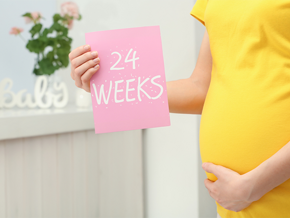
Recognizing the Signs of Labor: When It's Time to Go to the Hospital
As you reach the home stretch of your pregnancy, any new sensation (a different kind of pressure or persistent backache) might have you asking, "Is this it?" Understanding the signs of labor can help you plan for those final days and weeks, ensuring you’re ready for your baby's arrival.
While every birth experience is unique and symptoms vary, there are common indicators your body is getting ready. This guide will walk you through the early signs of labor and help you identify those important cues.
What Are the Early Signs of Labor?
You might notice the following signs your body is getting ready for labor as you move into the later stages of your third trimester (around 36 weeks or beyond for many):
1. Lightening or baby dropping lower
One of the first changes you might feel is lightening when your baby’s head descends lower into your pelvis to get into an optimal position for birth. You might suddenly find breathing easier as pressure on your diaphragm lessens. However, this shift also means increased pressure on your bladder.
Pregnant women can experience lightening differently. You may feel it or not at all! It can happen a few weeks before labor if you’re a first-time mom, or it can occur after labor begins if you’ve given birth before.
2. Increased urge to urinate
With your baby now nestled lower in your pelvis, you'll likely feel an increased need to urinate more often. While it can be a bit inconvenient, think of it as a positive sign that things are progressing and your body is making way for your baby.
3. Loss of the mucus plug
During pregnancy, a thick layer of mucus seals your cervix, acting as a protective barrier for your baby against infection. As your body prepares for labor, the cervix softens and opens, causing the mucus plug to come out.
You might see a clear, pinkish, or slightly bloody discharge, either all at once or gradually. This is sometimes called the "bloody show" and indicates cervical changes are underway. However, labor itself could still be hours, days, or even a week or so away, according to the American Pregnancy Association.
4. A nesting period
Suddenly feel an overwhelming desire to clean, organize, and prepare your home for the baby? That's your nesting instinct. Research published in Evolution and Human Behavior shows that many pregnant women experience this urge to prepare a safe, welcoming space for their little ones as their due date nears.
You might feel a surprising burst of energy or a drive to get everything "just right.' This is also a great time to check if you’ve got your newborn essentials ready. Just remember to listen to your body and don’t overexert yourself—you’ll want to save plenty of strength for giving birth and your new baby!
5. Lower back pain or pelvic pressure
As hormones like relaxin continue to soften your ligaments and your joints become more flexible in preparation for birth, you might experience a more persistent, dull ache in your lower back. You may also feel a sensation of heaviness and increased pressure in your pelvis and rectum due to the baby dropping lower. This discomfort may feel different from earlier aches—and it often signals that labor is near.
When Labor Is 24 to 48 Hours Away

More practice contractions, new cramps, or changes in discharge? Your baby might arrive in just a day or two!
As you get even closer to your due date, some signs might suggest that delivery is drawing nearer, possibly within the next day or two. These include:
- Frequent Braxton Hicks contractions, also known as false labor or practice contractions
- Changes in vaginal discharge, such as an increase in clear or pinkish watery release as cervical changes continue
- Diarrhea or nausea, possibly due to the release of the hormone prostaglandin, which helps soften and dilate the cervix
- Persistent mild cramping in your lower abdomen or back
Signs of Labor at 37 Weeks
Some women encounter prodromal labor in the third trimester, at 37 weeks. It's a type of false labor with contractions that can be more intense or regular than typical Braxton Hicks. They’re similar to true labor contractions, but don't consistently strengthen and progress into active labor (meaning no steady cervical dilation). They can also start and stop over hours or days.
True Labor vs. False Labor
It can be tricky to tell actual and false labor apart, especially if you're a first-time parent. Pay attention to your contractions and pain threshold to identify the signs of true labor.
Timing and frequency of contractions
Braxton Hicks contractions are sporadic, and they stop when you walk, rest, or change position. True labor contractions follow a consistent and predictable pattern. They don't stop or ease with changes in activity or position.
Real contractions gradually become closer together (for example, initially occurring 15 to 20 minutes apart and then reaching intervals of around five minutes). Each contraction typically lasts longer between 30 to 70 seconds, and the intensity steadily increases.
Pain location
You'll feel Braxton Hicks in the front of the abdomen or pelvic area. True labor typically starts in the lower back and radiates around to the front of your abdomen, or it may begin in the abdomen and radiate to the back. You might also feel discomfort in the pelvic area that radiates down into your thighs.
Pain intensity
Many describe Braxton Hicks as a tightening or mild cramping sensation that's more uncomfortable than intensely painful. The intensity usually remains the same or may even decrease.
Generally, true labor contractions cause noticeable tightening or hardening of the uterus. This might begin as a dull ache in your lower back that comes and goes or feel like menstrual cramps. These sensations become more intense, last longer, and occur more frequently as labor progresses.
What Are the Signs of Silent Labor?
The signs of silent labor are less obvious and less painful than you might expect. You might experience these as:
- Contractions that feel more like intense pressure or a strong ache rather than sharp pain
- Indigestion, general backache, or bowel discomfort until they suddenly intensify or the urge to push becomes apparent
- A rapid progression through the early stages of labor, sometimes in just a few hours
If you have a history of rapid labor (labor that progresses quickly, often lasting less than three to five hours) or if you experience increasing pelvic pressure, a sudden strong urge to have a bowel movement, or an unexpected urge to push, call your doctor immediately. You might not realize you’re in active labor until it's pretty advanced.
When to Go to the Hospital

Knowing when to go to the hospital is vital. Trust your instincts if water breaks or contractions are strong and regular.
Knowing when to head to the hospital is crucial for a safe birth. While your doctor will give you specific instructions based on your birthing plan, these general guidelines can help you decide when it's time:
- Your water breaks—a sudden gush of fluid or a slow, continuous trickle.
- You have strong, regular contractions.
- You’re experiencing significant vaginal bleeding that’s bright red.
- You feel severe, constant pain that doesn’t subside or ease up between contractions.
Having your pregnancy hospital bag checklist completed and easily accessible will make this moment much smoother, allowing you to focus on the task ahead.
Now that you know the signs of labor, you can approach your birthing day with confidence and calm. Remember to discuss any of these signs with your doctor as they emerge, since they’re your best resource for guidance.
Feeling nervous about the signs of labor and giving birth? Join the ParentTeam Moms and Dads Facebook group and get support during this incredibly exciting period in your life.
References
American College of Obstetricians and Gynecologists (ACOG). "How to Tell When Labor Begins." acog.org. Last reviewed November 2023. Accessed May 27, 2025. https://www.acog.org/womens-health/faqs/how-to-tell-when-labor-begins.
Cleveland Clinic. "Contractions." Cleveland Clinic. Last reviewed August 8, 2024. Accessed May 29, 2025. https://my.clevelandclinic.org/health/symptoms/contractions.
Cleveland Clinic. "Prodromal Labor (False Labor): Causes, Symptoms & Duration." Cleveland Clinic. Last reviewed September 15, 2022. Accessed May 30, 2025. https://my.clevelandclinic.org/health/symptoms/24163-prodromal-labor.
Healthy Start HHP. "Lightening in Pregnancy: When Does Baby Drop?" healthystarthhp.org. Accessed May 29, 2025. https://www.healthystarthhp.org/lightening-in-pregnancy/.
Hong, Shanshan, Liying Chen, Huihong Zhuang, Yanting Wang, Tiantian Lin, Tong Jin, and Jiawei Qin. "Prevalence of lumbopelvic pain during pregnancy: A systematic review and meta-analysis of cross-sectional studies." Acta Obstetricia et Gynecologica Scandinavica 103 (2024): 225–40. https://doi.org/10.1111/aogs.14714.
Hutchison, J., et al. "Normal Labor: Physiology, Evaluation, and Management." In StatPearls [Internet]. Treasure Island (FL): StatPearls Publishing, 2025. Last updated February 15, 2025. Accessed May 29, 2025. https://www.ncbi.nlm.nih.gov/books/NBK544290/.
Mayo Clinic Staff. "Signs of labor: Know what to expect." Mayo Clinic. July 23, 2024. Accessed May 29, 2025. https://www.mayoclinic.org/healthy-lifestyle/labor-and-delivery/in-depth/signs-of-labor/art-20046184.
Mayo Clinic Staff. "Preterm labor." Mayo Clinic. January 18, 2025. Accessed May 29, 2025. https://www.mayoclinic.org/diseases-conditions/preterm-labor/symptoms-causes/syc-20376842.
NHS. "Signs that labour has begun." nhs.uk. Last reviewed November 9, 2023. Accessed May 29, 2025. https://www.nhs.uk/pregnancy/labour-and-birth/signs-of-labour/signs-that-labour-has-begun/.
NHS. "Week 34." Start for Life, nhs.uk. Accessed May 29, 2025. https://www.nhs.uk/start-for-life/pregnancy/week-by-week-guide-to-pregnancy/3rd-trimester/week-34/.
Pregnancy, Birth and Baby. "Giving birth - early signs of labour." pregnancybirthbaby.org.au. Last reviewed October 2023. Accessed May 29, 2025. https://www.pregnancybirthbaby.org.au/giving-birth-early-signs-of-labour.
Singh, Arjun. "Silent Labor: An Overview." iCliniq.com. Medically reviewed by Dr. Khushbu. Last reviewed July 16, 2024. (Originally published December 11, 2023). Accessed May 29, 2025. https://www.icliniq.com/articles/pregnancy-and-trying-to-conceive/silent-labor.
Sutter Health. "Pre-Labor vs. True Labor: How can you tell if you're really in labor?" Sutter Health. September 27, 2024. Accessed May 29, 2025. https://www.sutterhealth.org/health/pre-labor-vs-true-labor.




























